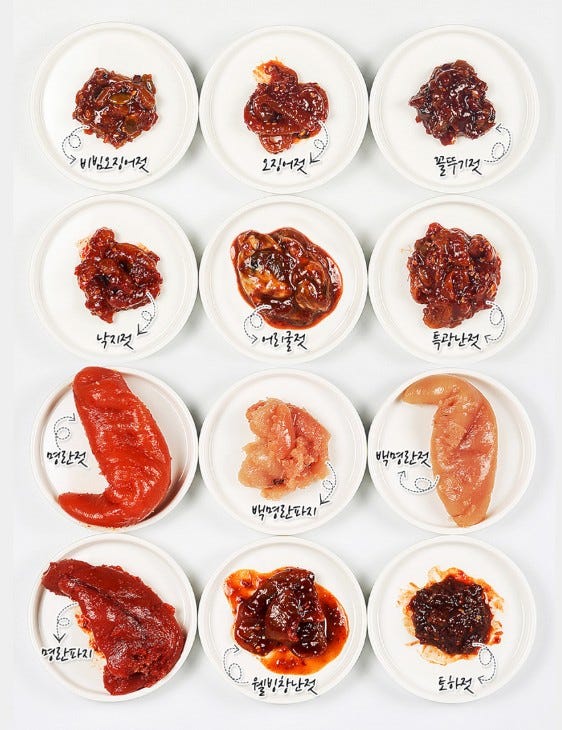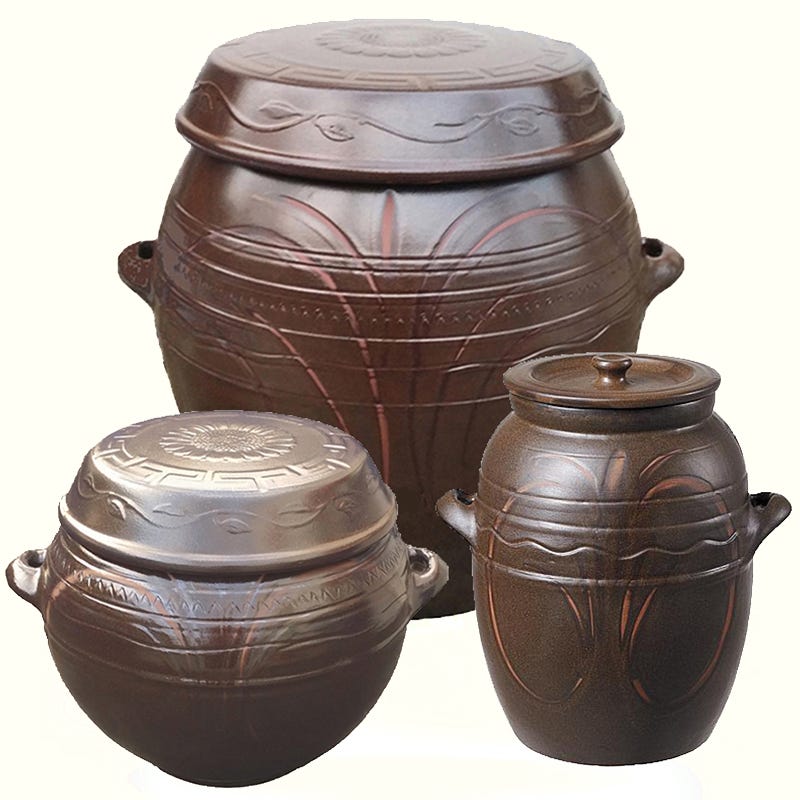In my kimchi posting last week, I’ve teased about a crazy story involving this “jeotgal” thing from a NIH study on the traditional Korean fermented foods. So, let’s begin with finding out what jeotgal (젓갈 or 젓, pure Korean word) is.
First off, you have to be careful with the spelling. The bottom part of the word 젓 must be a “ㅅ” and not a “ㅈ.” 젓 and 젖 are pronounced exactly the same—like “jut” as in “Cape Cod juts out of Massachusetts”—but are completely different words.
젓(갈): the fermented and heavily seasoned Korean food
젖: breasts, or milk
But honestly, many Koreans confuse the two, as is the case in the English-speaking world with “there” and “their.”

Jeotgal is a fermented, by way of salting, seafood. You know how the story goes. Seafood in the olden days without refrigeration would rot in a day or two, so our ancestors figured out a way to preserve them by heavily salting and letting them “age,” which by definition is fermentation—letting food go through chemical reaction to develop flavor in a natural way.
This, of course, is not unique to Korea or Asia. As I understand it, Scandinavian peoples preserved their fish in salt as well; there’s the famous Vietnamese fish sauce called nuoc mam; and what do you think those canned anchovies and sardines are? They’re basically European jeotgal.
And get this. So is ketchup. Did you know that the name “ketchup” is actually derived from a Chinese word that means “brine of fermented fish”? Google “origin of ketchup” and see what comes up. You’ll be surprised.
Like kimchi, there are literally over 200 different types of jeotgal in Korea.
A few are shown here, and I’ll pick out one to illustrate a point. Let’s take the top middle one. It says “오징어젓.” Do you recognize those first three characters in Korean?
Yes, it’s “squid.” How do you make a squid jeotgal, or any jeotgal for that matter? Clean it, take out the skin and/or any other debris, slice it into thin strips, or chop it up finely (depending on your preference), salt it generously, and store/age it in a Korean earthenware called 항아리 (hang-ari) for a few days or up to over a year, depending on the ingredient. You cannot make kimchi without a certain type of jeotgal. The more types you have, the deeper the flavor of kimchi.
These are then removed in small batches, and further seasoned with Korean chili flakes/powder (고추가루, go-choo-ga-roo), garlic, and other flavors. They can get spicy and very pungent. For example, there is a jeotgal (not pictured above) made with the innards of beltfish (갈치, aka hairtail, cutlass fish) and it has a very unique odor/smell to it (= it stinks), not all that dissimilar from a bad smelling cheese like Stilton or Limburger.
But Korean barbecue restaurants in Jejudo serve it as a dipping sauce for pork belly (삼겹살), and once you get used to it, there’s no turning back—it’s very addictive. So, in short, jeotgals are fermented seafood that’s been chopped up, salted, and seasoned. They’re definitely an acquired taste, even for many Koreans, but very common banchan in a Korean meal.
The Josun Dynasty (1392~1897) produced 27 Kings and countless anecdotes. They’re a gold mine for someone like me, who writes stories about Korea. Over time, I will cover those as much as I can. Today, we’re going to talk about the 10th King of Josun Dynasty, officially named Yeon-san-guhn (연산군, 燕山君, Prince Yeon-san).
A factoid about Korean history—the official titles of Josun Dynasty Kings end in either -jong (종, 宗) or -jo (조, 祖). The suffix simply denotes “King” and there is no clear difference between the two, although some archaic Chinese text has a very ambiguous description of what that difference is. Modern Korean historians agree that there is essentially no distinction.
Anyway… of the 27 Kings, there are 2 who do NOT have their moniker end in jong or jo. They end in 군, (君, guhn) meaning “prince.” They’re named as such because they didn’t deserve to be called a King for being a murderous tyrant and psychologically unstable. One of two is of course Yeon-san, for whom alone I can write 20 different postings about his Caligula-esque atrocities that he committed during his 12-year reign. But I’ll concentrate on one episode that’s pertinent to today’s topic.

You see, Yeon-san was the oldest son of Sung-jong (성종, 成宗) who is one of the most respected Kings of Josun Dynasty in terms of achievements and his “kingly” disposition. But Yeon-san’s biological mother, Queen Yoon (no given name recorded), was stripped of her title, divorced, expelled from the Palace, and eventually sentenced to death for conduct unbecoming of a Queen (she did some shitty things—like trying to frame other people, attempting to poison her rivals (caught red-handed), brazenly doing things on the Palace grounds that the Josun law expressly prohibited). She was killed when Yeon-san was 6 years old.
Yeon-san found out about what had happened to his mother (people were apparently keeping quiet about it for years), he went on a rampage, killing people who were involved with the incident. By this time, however, Yeon-san was already on his batshit crazy behavior for a couple of years. His mother Queen Yoon’s rivals, as they were, were his father’s two concubines who won favors from King Sung-jong during his reign. And Yeon-san, thinking that it was those two concubines, Um and Jeong, who were the direct cause of his mother’s death, started torturing them. Then, Yeon-san summoned Um and Jeong’s sons—remember, they’re Yeon-san’s half-brothers—and ordered them to club the two “criminals.”
This torturing session was held under the darkness, and they couldn’t see who the “criminals” were, so one of them obliged to the King’s command and ended up beating his own mother, and the other, knowing who the tied person was, couldn’t obviously bring himself to do it. The two women, Yeon-san’s father’s women, were beaten to death that night, their corpses chopped up and made into a jeotgal.
Before anyone imagines anything more horrifying than it already is, they were reportedly thrown in the nearby mountains.
They don't teach you this in schools—too many gruesome details. But they are indeed recorded in the “Veritable Records of Joseon Dynasty.” (조선왕조실록, 朝鮮王朝實錄, Josun-wangjo-shillok)
So, there it is, the story involving jeotgal and a King.











